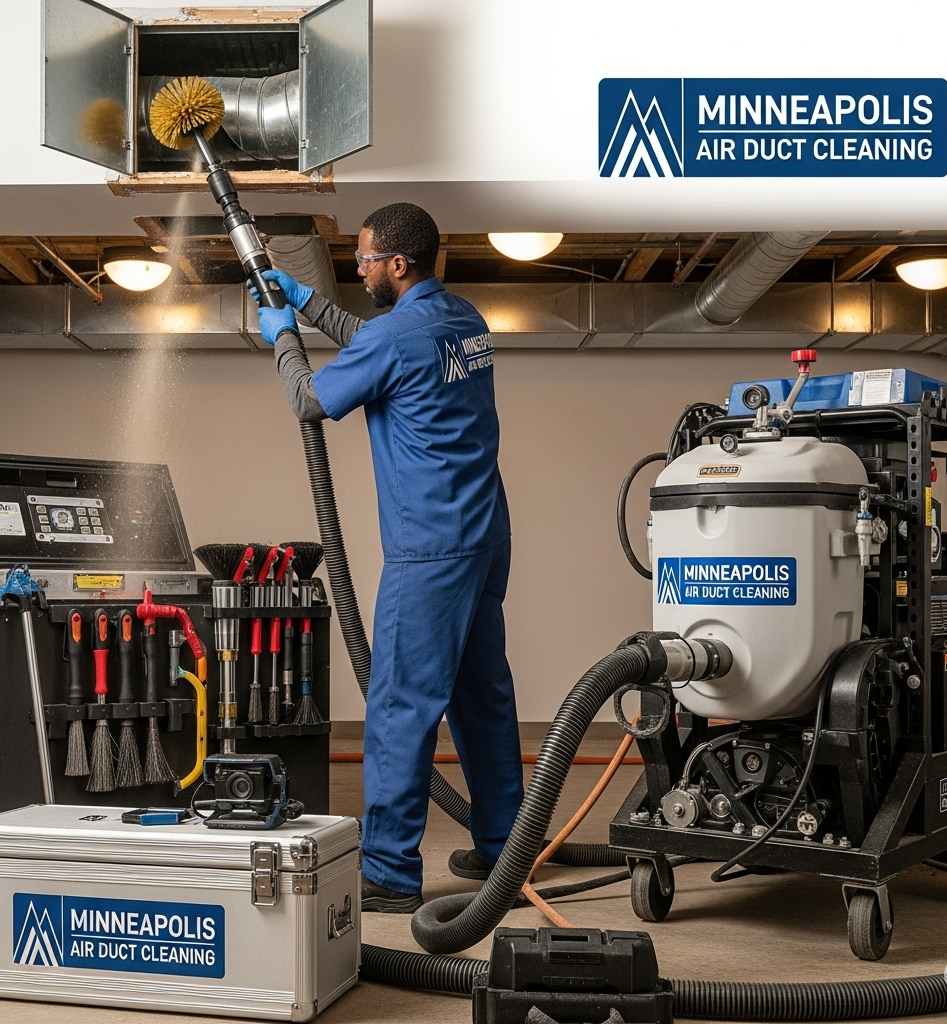
Negative Pressure Air Duct Cleaning
Living in Minneapolis, with its mix of humid summers and snowy winters, you might find yourself wondering about the stuff growing inside your air ducts. If you’ve ever sniffed a musty odor when the heater turns on or noticed strange black spots around your vents, you’re not alone. Mold loves damp, dark spaces, and air ducts are prime real estate. Many homeowners hear about negative pressure air duct cleaning and hope it’s the solution to their mold woes. But does this method really boot mold out for good? Let’s dig in, step by step, and find out what’s fact and what’s just hot air.
Understanding Negative Pressure Air Duct Cleaning
Imagine someone sucking up dust from your carpets with a powerful vacuum, but for your entire duct system. That’s the basic idea behind negative pressure air duct cleaning. A huge vacuum machine, often mounted on a truck outside your home, is connected to your ducts. When it’s fired up, it creates a strong pull—like a giant straw—drawing out dust, debris, and whatever else is lurking inside those airways. Technicians go room to room, using brushes or air whips to dislodge stubborn gunk, which the vacuum then whisks away.
The “negative pressure” part just means the air inside the ducts is being pulled out faster than it can come in, which helps grab all the loose particles and hopefully, any freeloading mold spores along for the ride.
Does This Method Actually Remove Mold?
Here’s the honest answer: Negative pressure cleaning can remove a good amount of mold spores and visible growth, especially the stuff that’s loose or lightly stuck to the duct surfaces. When mold is simply dusted around, this method vacuums it up, helping your air feel fresher and less musty. But, and it’s a big but, if the mold has really taken hold—like it’s grown a thick, fuzzy mat or sunk its roots into the duct material—suction alone might not cut it.
Some mold clings stubbornly, almost like it’s glued to the metal or insulation. In these cases, extra steps like scrubbing, chemical treatments, or even replacing parts of the ductwork may be needed. Negative pressure is a fantastic first step, but not always the final answer for serious mold problems.
“Negative pressure air duct cleaning is a powerful tool, but it’s not magic—it grabs what’s loose, but stubborn mold may need a little extra muscle.”
The Mold Removal Table: What Happens During Cleaning?
| Step | What Happens | Mold Removal Effect |
|---|---|---|
| 1. Inspection | Technician checks ducts for visible mold and moisture | Locates problem areas, but doesn’t remove mold |
| 2. Set Up Vacuum | Large vacuum hose is attached, creating negative pressure | Prepares for suction, but mold still present |
| 3. Agitation | Brushes or air whips are used to loosen debris | Dislodges some mold spores and growth |
| 4. Vacuuming | Loose material is sucked out of the ducts | Removes loose mold, but not deeply embedded colonies |
| 5. Optional Treatment | Sanitizers or biocides may be applied | Kills remaining spores, helps prevent regrowth |
Why Minneapolis Homes Are Prone to Duct Mold
Our city’s wild temperature swings mean that condensation is common—think of all those snow boots melting near your vents or summer humidity sneaking inside. When warm, moist air meets cold metal ducts, it creates drops of water. Mold only needs a little moisture and a dark place to thrive, so it’s no surprise it often shows up in Minneapolis homes, especially after a long, damp spring or a basement flood.
That’s why regular cleaning makes sense here. Even if you don’t see mold, keeping ducts clear reduces the chances of it setting up shop behind your walls.
How to Tell If You Need More Than Just Cleaning
So, when is a simple negative pressure cleaning enough, and when do you need to call in the big guns? If the mold is just a light dusting or you’re only smelling a faint mustiness, a good cleaning might do the trick. But if you see thick patches, feel sick when the heat comes on, or keep finding new spots after cleaning, it’s time to consider mold remediation with specialized treatments. Sometimes, ducts with heavy contamination are better off being replaced. Don’t be afraid to ask your technician for an honest assessment.
Key Features
- Uses powerful vacuum systems to pull out debris and spores
- Often combined with brushes or air jets for thorough cleaning
- Optional sanitizing step to discourage mold from returning
Safety
- Technicians wear protective gear to avoid breathing in spores
- Proper containment prevents spreading mold into your living space
- After cleaning, indoor air quality is usually much improved
Cost
- Standard cleaning in Minneapolis can range from $400–$900, depending on home size and duct complexity
- Severe mold problems may require additional remediation, increasing the price
Emergency Service
- Some companies offer same-day or next-day mold cleaning for urgent problems
- Quick response can prevent mold from spreading further
Conclusion
Negative pressure air duct cleaning is a solid way to tackle mold in your Minneapolis home, especially if you catch it early. It’s great at pulling out loose spores and giving your air a fresh start, but it may not wipe out deeply rooted mold without a little extra help. If you’ve got a persistent mold issue, combining cleaning with professional treatments or repairs might be the best route. Keeping up with regular duct maintenance can go a long way in keeping that musty smell (and the mold behind it) at bay. After all, clean air is something every Minneapolis homeowner deserves—no matter what the weather is doing outside.
Read More: Minneapolis Air Duct Cleaning



